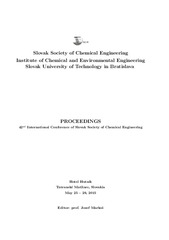Приказ основних података о документу
Hydrolysis of egg white and wheat proteins with protease from bacillus licheniformis: fractionation and identification of bioactive peptides
| dc.creator | Knežević-Jugović, Zorica | |
| dc.creator | Jovanović, Jelena | |
| dc.creator | Stefanović, Andrea | |
| dc.creator | Grbavčić, Sanja | |
| dc.creator | Šekuljica, Nataša | |
| dc.creator | Elmalimadi, Mohamed B. | |
| dc.creator | Bugarski, Branko | |
| dc.date.accessioned | 2023-03-21T14:43:57Z | |
| dc.date.available | 2023-03-21T14:43:57Z | |
| dc.date.issued | 2015 | |
| dc.identifier.isbn | 978-80-89475-14-8 | |
| dc.identifier.uri | http://TechnoRep.tmf.bg.ac.rs/handle/123456789/6271 | |
| dc.description.abstract | Wheat gluten is a relatively inexpensive industrial byproduct from wheat starch processing, and in Europe also from manufacturing of bioethanol fuel. Egg producers are also faced with problems of excess of egg white because mayonnaise industry and bakery industry use relatively high egg yolk amounts and egg white is the remainder. Of high importance is the production of new value-added products based on gluten and/or egg white proteins with improved properties and specialized functionality to be used in food and biobased consumer products. The objective of this research was a production of both wheat gluten and egg white protein hydrolysates with improved antioxidant properties. For this purpose, both substrates were pretreated by thermal treatment and then intensively hydrolysed with a commercial food-grade bacterial protease, Alcalase. Thus, the obtained hydrolysates were further separated by sequential ultrafiltration into four peptide fraction viz. Fraction I (> 30kDa), II (10 - 30 kDa), III (1 - 10 kDa) and IV (< 1kDa) which were investigated in terms of their antioxidant activity. The antioxidant activity of hydrolysates and peptide fractions were evaluated using 1,1-diphenyl-2-picrylhydrazyl (DPPH), 2,2′-azinobis(3-ethylbenzothiazoline-6-sulphonic acid) diammonium salt (ABTS) radical scavenging assays and measuring ferric reducing antioxidant power assay. Scavenging of 2,2′- diphenyl-1-picrylhydrazyl (DPPH) and 2,2′-azinobis(3-ethylbenzothiazoline-6-sulphonic acid) diammonium salt (ABTS) by Fraction III, prepared with gluten protein was found to be significantly higher than other gluten or egg white fractions. The results show that the fractionated hydrolysates were superior to the original hydrolysate in the antioxidative activity tested in all cases and can be concluded that by combining thermal pretreatment and controlled enzymatic hydrolysis, the hydrolysates with improved antioxidant properties can be produced enhancing utilization of egg white and gluten in food products. | sr |
| dc.language.iso | en | sr |
| dc.publisher | Bratislava, SK : Slovak Society of Chemical Engineering | sr |
| dc.relation | EUREKA project / ENZEGG E!6750 - Development of enzyme processes for production of egg white protein hydrolysates | sr |
| dc.relation | Innovation Project / Production of new dietary formulations based on natural protein with antioxidant and antitumor effect | sr |
| dc.rights | openAccess | sr |
| dc.rights.uri | https://creativecommons.org/licenses/by-nc-nd/4.0/ | |
| dc.source | Proceedings / 42nd International Conference of SSCHE Tatranské Matliare | sr |
| dc.subject | Antioxidant peptides | sr |
| dc.subject | Membrane ultrafiltration | sr |
| dc.subject | Egg white proteins | sr |
| dc.subject | Gluten | sr |
| dc.subject | Enzymatic hydrolysis | sr |
| dc.title | Hydrolysis of egg white and wheat proteins with protease from bacillus licheniformis: fractionation and identification of bioactive peptides | sr |
| dc.type | conferenceObject | sr |
| dc.rights.license | BY-NC-ND | sr |
| dc.citation.spage | 753 | |
| dc.identifier.fulltext | http://TechnoRep.tmf.bg.ac.rs/bitstream/id/16561/SSCHE2015-proceedings-abstract-Knezevic-Jugovic.pdf | |
| dc.identifier.rcub | https://hdl.handle.net/21.15107/rcub_technorep_6271 | |
| dc.type.version | publishedVersion | sr |

